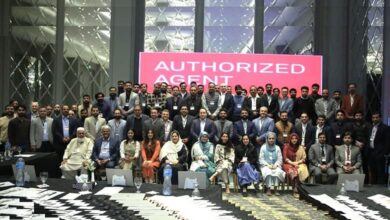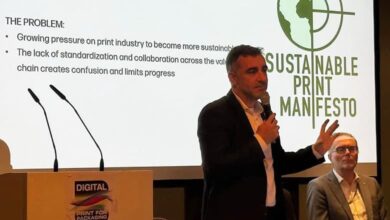Printing and Publishing Group Holds “Beyond Conventional Printing” Seminar
Printing Publishing Group (PPG) organized one of its most successful events to date during which international experts introduced new ideas in the world of printing. The concepts explained by the speakers will help printers find additional revenue stream. PPG seminar dubbed as “Beyond Conventional Printing” was held on April 9th at Le Meridien Hotel. Keynote speakers included Dr. Nicholas Hellmuth from FLAAR Report, Edward Alves, from 3D Business Development Company and Phil Walsh from Kodak UK.
Following the welcoming speech by Andrew Hurt member of PPG and Strategic Development manager for Mohamed Hareb al Otaiba Group Nicholas Hellmuth kick started part one of its first presentation which dealt with future of inkjet technology.
According to Hellmuth the future of inkjet has got to do more with the ink and printhead than anything else. On the other hand today most volume of inkjet printing is on PVC vinyl for building wrap and billboards. However these traditional signage applications are being replaced by LED electronic signage. So in order for large format printing to survive Hellmuth suggests using eco-friendly materials such as PE. On the other there are a host of innovative application that can add to the attractiveness of large format printing. Applications such as deep relief printing, printing on glass, printing on ceramic tiles, printing on wood and printing on metal.
Hellmuth believes large format printing definitely has potential but printers have to look beyond conventional signage and explore new territories. For these applications flatbed printers works much better. That’s why it seems that future of flatbed printers almost certainly is guaranteed. Second part of Hellmuth’s presentation was dedicated to printing on innovative materials such as lightweight honeycomb sandwich board. It is made of Kraft paper which is often already recycled. You can print on its printable exterior using a flatbed printer. You can make furniture, signage or an entire house with it. Next presentation covered a topic which we hear a lot these days, hence 3D printing.
3D Printing
Edward Alves, from 3D Business Development Company offered a rather detailed round up on 3D technologies available and the 3D printing trends which surprisingly enough is not a new technology and has been around for more than two decades. Alves said that 3D printing technologies experimented with in the late 60’s and the first commercially available machine was the SLA 1 which was introduced by 3D Systems in 1988. All of the 3D technologies we exist today were developed before 1995 and most of the advancement since then are related to materials and speed.
In 1986 First 3D printer sold and in 2013 more than 60000 3D printers were sold to people and companies across the globe. However more than 90% of the printers sold during 2013 had a price tag of 5000 or less. It shows that the staggering increase in 3D printing sales is mostly because its price has dropped significantly and now consumers can purchase it. It is projected that in 2014 more than 900000 3D printers will be sold but most of them will be desk top printers. Currently 150 estimated desktop 3D printers are being sold per day. There are actually different 3D printing technologies which include, FDM (Fused Deposition Modelling), Multijet Printing, SLA (Stereo Lithography), SLS (Selective Laser Sintering) and CJP (Colour Jet Printing).
Blend of inkjet and offset
Third and last presentation was carried out by Phil Walsh from Kodak. Walsh focused on Kodak’s flagship inkjet technology called Stream. According the Walsh Stream can fill the existing gap between digital and offset printing technologies. Each of these printing processes have advantages and disadvantages. For example digital printing inks are expensive on the other hand offset technology cannot be used for personalization. One solution would be to blend of digital and offset and come up with a hybrid press. However in the current hybrid workflow, lots of steps are involved in the moving, warehousing, and handling of preprinted shells.
Kodak has come up with a different solution. Company’s inkjet heads are directly mounted on web offset presses for additional inline personalization of printed products. The applications are just mind boggling according to Walsh. Using the technology printer can easily static offset shell with colour imprinted VDP. Other application include addressing covers, tracking and tracing packaging, personalised mail and documents and the list goes on.
A Successful Event
During past years PPG has organized a number of informative seminars. However as far as the quality of presentation and number of attendees are concerned Beyond Conventional Printing is definitely is on the top of the list.





